
A dragon is a large magical legendary creature that appears in the folklore of multiple cultures worldwide. Beliefs about dragons vary considerably through regions, but dragons in western cultures since the High Middle Ages have often been depicted as winged, horned, and capable of breathing fire. Dragons in eastern cultures are usually depicted as wingless, four-legged, serpentine creatures with above-average intelligence. Commonalities between dragons' traits are often a hybridization of feline, reptilian, mammal, and avian features. Scholars believe vast extinct or migrating crocodiles bear the closest resemblance, especially when encountered in forested or swampy areas, and are most likely the template of modern Asian dragon imagery.

A Gorgon is a creature in Greek mythology. Gorgons occur in the earliest examples of Greek literature. While descriptions of Gorgons vary, the term most commonly refers to three sisters who are described as having hair made of living, venomous snakes and horrifying visages that turned those who beheld them to stone. Traditionally, two of the Gorgons, Stheno and Euryale, were immortal, but their sister Medusa was not and was slain by the demigod and hero Perseus.
The Tupi-Guarani mythology is the set of narratives about the gods and spirits of the different Tupi-Guarani peoples, ancient and current. Together with the cosmogonies, anthropogonies and rituals, they form part of the religion of these peoples.
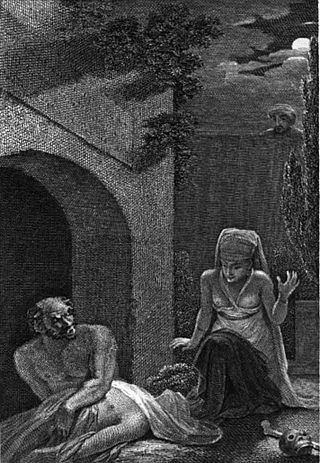
A ghoul is a demon-like being or monstrous humanoid, often associated with graveyards and the consumption of human flesh. The concept originated in pre-Islamic Arabian religion. Modern fiction often uses the term to label a specific kind of monster.
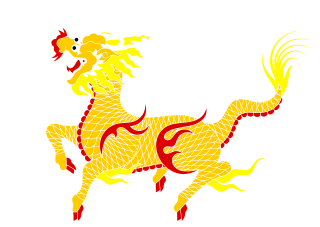
The qilin is a legendary hooved chimerical creature that appears in Chinese mythology, and is said to appear with the imminent arrival or passing of a sage or illustrious ruler. Qilin are a specific type of the lin mythological family of one-horned beasts. The qilin also appears in the mythologies of other Chinese-influenced cultures.

In New Jersey and Philadelphia folklore in the United States, the Jersey Devil is a legendary creature said to inhabit the forests of the Pine Barrens in South Jersey. The creature is often described as a flying biped with hooves, but there are many variations. The common description is that of a bipedal kangaroo-like or wyvern-like creature with a horse- or goat-like head, leathery bat-like wings, horns, small arms with clawed hands, legs with cloven hooves, and a forked or pointed tail. It has been reported to move quickly and is often described as emitting a high-pitched "blood-curdling scream".

The bogeyman is a mythical creature used by adults to frighten children into good behaviour. Bogeymen have no specific appearance and conceptions vary drastically by household and culture, but they are most commonly depicted as masculine or androgynous monsters that punish children for misbehaviour. The bogeyman and conceptually similar monsters can be found in many cultures around the world. Bogeymen may target a specific act or general misbehaviour, depending on the purpose of invoking the figure, often on the basis of a warning from an authority figure to a child. The term is sometimes used as a non-specific personification of, or metonym for, terror, and sometimes the Devil.

Bala Lake is a large freshwater glacial lake in Gwynedd, Wales. The River Dee, which has its source on the slopes of Dduallt in the mountains of Snowdonia, feeds the 3.7 miles (6.0 km) long by 0.5 miles (0.8 km) wide lake. It was the largest natural body of water in Wales even before its level was raised by Thomas Telford to provide water for the Ellesmere Canal.

The manananggal is a mythical creature in the Philippines that is able to separate its upper torso from the lower part of its body. Their fangs and wings give them a vampire-like appearance.
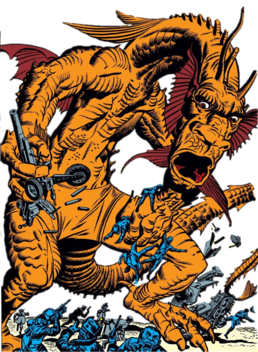
Fin Fang Foom is a fictional character appearing in American comic books published by Marvel Comics. The character has been depicted as an extraterrestrial creature resembling a dragon. The character first appeared in Strange Tales #89, and was created by Stan Lee and Jack Kirby. Later, the character becomes part of the superhero Iron Man's rogues gallery.

According to the Bible, the golden calf was an idol made by the Israelites when Moses went up to Mount Sinai. In Hebrew, the incident is known as ḥēṭə’ hā‘ēgel or "the sin of the calf". It is first mentioned in the Book of Exodus.
My Pet Monster is a character that began as a plush doll first produced by American Greetings in 1986. It has horns, blue fur, a fanged smile, and wears breakaway orange plastic handcuffs.
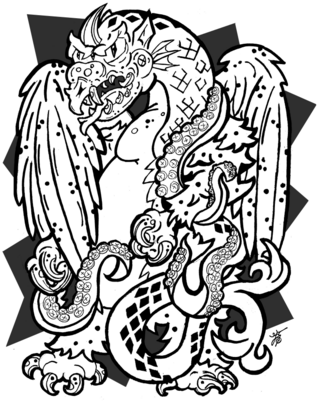
In American folklore, the snallygaster is a bird-reptile chimera originating in the superstitions of early German immigrants later combined with sensationalistic newspaper reports of the monster. Early sightings associate the snallygaster with Frederick County, Maryland, especially the areas of South Mountain and the Middletown Valley. Later reports would expand on sightings encompassing an area to include Central Maryland and the Washington, DC, metro area.

Colombian folklore are beliefs, customs and cultural traditions in Colombia.
In West Virginia folklore, the Mothman is a humanoid creature reportedly seen in the Point Pleasant area from November 15, 1966, to December 15, 1967. The first newspaper report was published in the Point Pleasant Register, dated November 16, 1966, titled "Couples See Man-Sized Bird ... Creature ... Something". The national press soon picked up the reports and helped spread the story across the United States. The source of the legend is believed to have originated from sightings of out-of-migration sandhill cranes or herons.
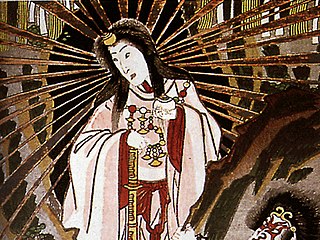
A Japanese urban legend is a story in Japanese folklore which is circulated as true. These urban legends are characterized by originating in or being popularized throughout the country of Japan. These urban legends commonly involve paranormal entities or creatures who encounter and attack humans, but the term can also encompass widespread, non-supernatural rumors in popular culture. Urban legends in the former category rarely include the folklore yōkai, instead of being primarily based on contemporary examples of yūrei. Modern Japanese urban legends tend to occur in schools or urban settings, and some can be considered cautionary tales.
A monstrous birth, variously defined in history, is a birth in which a defect renders the animal or human child malformed to such a degree as to be considered "monstrous". Such births were often taken as omens, signs of God, or moral warnings to be wielded by society at large as a tool for manipulation in various ways. The development of the field of obstetrics helped do away with spurious associations with evil but the historical significance of these fetuses remains noteworthy. In early and medieval Christianity, monstrous births were presented as and used to pose difficult theological problems about humanity and salvation.

The gargoyle is a fantasy and horror monster inspired by the gargoyle architectural element. While they were believed in mythology to frighten away evil spirits, the idea of such statues physically coming to life is a more recent notion. Like golems, they are usually made of magically animated or transformed stone, but have animal or chimera traits and are often guardians of a place such as a cathedral or castle. They can also be depicted as vessels for demonic possession or as a living species resembling statues.
















